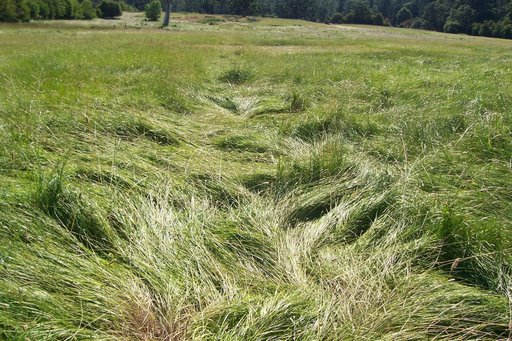- In early June, 2008 a Canadian pilot discovered what
has turned out to be a most interesting new crop circle. It's date of
origin appears to have been in very early June on land which is owned
by the Nature Conservancy--an area in which an attempt is being made to
reinstate the native wild prairie plant species on land which has been
cultivated for years. An aerial photo shows an interesting and moderately
complex overall design, but with a distinctly "mottled" look
-- caused by the patches of reintroduced wild plants throughout the field.
-
-

-
-
- On ground inspection a very "fluid" plant lay
was seen in many parts of the formation, a hallmark of circles around
the world in which multiple indicators (the scientifically-demonstrated
plant/soil changes) of the genuine crop circle phenomenon have also been
found.
-

-
-
- Another indicator that mechanical flattening of the plants
was not the answer in this case were the multiple areas in which circular
components were only partially flattened--areas which had maintained
their half-flattened but circular positioning for at least 3 weeks by
the time these photos were taken. Additionally, there was no indication
whatsoever of damage to the grasses in these areas.
-
-

-
-
- The best-documented plant change found in authentic crop
circles is apical node elongation--a stretching of the external fibers
of the top node beneath the seed-head--caused by escaping steam from these
nodes (a result of very brief but intense exposure of the plants to microwave
radiation). In this particular formation the node elongation was observed
to be massive, and clearly visible throughout:
-
-

-
-
-
- But this was not the most interesting observation reported.
Fieldworkers reported standing clumps of the reintroduced native prairie
species throughout the formation--none of which were flattened. It seems
that only the grasses introduced by farmers to this field years ago had
been flattened to create the formation.
-
- This sort of precision and selectivity has been seen
in crop circles before, but never to my knowledge quite so clearly.
-
-

-
-
-
- Did the crop circle energy system "choose"
which plants to flatten and which to leave standing? Was this energy
attracted only to the previously-cultivated grasses for some reason that
is important for us to better understand? Might this be an indicator
that we should be paying greater attention to our land cultivation practices?
-
- I have eaten organically for many years now, having gone
through a cancer which (according to my doctors) was most likely related
to elevated hormone levels--the same hormone levels known to be elevated
in aquatic mammals whose habitat is inundated with pesticide run-off
from farm fields. I can't help but wonder if the selectivity expressed
in this crop formation is significant.
-
- For the full report see:
- http://www.bltresearch.com/fieldreports/ july2008a.html
-
-
- Nancy Talbott
- BLT Research Team Inc.
- P.O. Box 400127
- Cambridge, MA 02140 (USA)
-
- ph: 617/492-0415
- web-site: www.bltresearch.com
|




